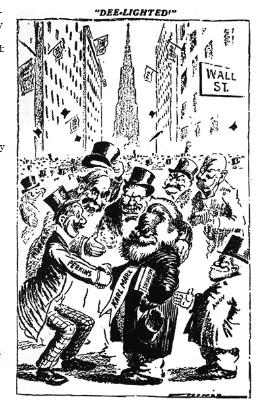"The International Jew" Study Hour - Episode 25
Dec. 13, 2012

Carolyn Yeager and Hadding Scott read and comment on Chapter 20, Jewish Testimony in Favor of Bolshevism.
“The Jew believes the world is his by right” and has found that revolution is the speediest way to gain it. The revolutionaries criticize the Gentile capitalists, but not the Jewish capitalists; in fact, this chapter proclaims “the Bolshevik revolution was a carefully groomed investment on the part of International Jewish Finance.”
Quoting from The Jewish Chronicle (London), writer Israel Zangwill, Rabbi J.L. Magnes, Bernard Lazare, and a Mr. Cohan writing in the newspaper Communist, their proud support for the “Jewish Revolutionary Spirit” is shown.
Finally, what Jewish capitalism has gained from Bolshevism: 1) A whole rich country (Russia), without the cost of war. 2) Demonstrated the necessity of gold; the fiction that gold is wealth. 3) Demonstrated its power to the world, i.e. making Europe afraid. 4) Valuable practice in the art of revolution … coming next to the United States.
Image: Political cartoon from 1911 St. Louis Post-Dispatch showing Karl Marx receiving a big welcome on Wall St. from Gentile financiers Rockefeller, Morgan and Flynn, plus Teddy Roosevelt. Another instance of Gentile capitalists being blamed instead of Jewish ones.
Note: We are using the Noontide Press publication of The International Jew — The World’s Foremost Problem which can be found online here as a pdf file.
Category
International Jew Study podcast, Jews- 1025 reads










Comments
Original comments on this program
20 Responses
Hadding
December 14, 2012 at 6:31 am
This is why I say that the Statue of Liberty is really a statue of Helios (Sun):
“In my right hand I carried a lighted torch, and a garland of flowers was upon my head, with white palm-leaves sprouting out on every side like rays; thus I was adorned like unto the sun….” (Apuleius, Metamorphoses, bk. 11)
This character Lucius, from Apuleius’ novel of the second century A.D., was dressed like this so that he could be the center of a religious ceremony.
Apparently on CLOSE examination, the “Statue of Liberty” turns out to be a female figure dressed in that manner, but it’s a representation of a female figure costumed as a male deity, Helios. Hence the solar rays emanating from the head.
If you examine the image of Liberty from the seated Liberty half-dime (first issued in 1839)you see that there are no rays coming from the head. On the 1849 double eagle, Liberty has a modest tiara bearing the word LIBERTY, but no rays emanating from the head. Likewise the Liberty-Head Nickel (1883-1912). Likewise the depiction of Libertas on a Roman coin. Rays emanating from the head do not seem to be traditional attributes of Liberty, rather of Helios.
There is a semblance of appropriateness in having a statue of Helios stand at the port of entry for the United States, since in Apuleius’ novel the ceremony in which Lucius dons that costume marks the end of a life of troubles (since he had spent some time magically transformed into a jackass) and the beginning of a life of reason and good fortune. But I think it may have been anticipated that Americans would not appreciate the reference, since some elements in other parts of Apuleius’ story are indecent.
Carolyn
December 14, 2012 at 9:46 am
Hadding is referring to this picture I sent him showing boobies on Lady Liberty: http://shedexpedition.com/statue-of-liberty-new-york/
Scroll down to bottom of page to see the two best pictures in bright sunlight.
Hadding
December 14, 2012 at 1:44 pm
While I was looking for images of Liberty on old coins I noticed that the face on the Mercury Dime also looks feminine. Sure enough, it is generally believed that the model for “Mercury” on the dime was one Elsie Stevens.
It’s a peculiar thing, this proclivity for having women dress as male Graeco-Roman gods.
Hadding
December 15, 2012 at 7:04 am
Israel Zangwill was born 1864 in London. His parents were from Russia.
EvelynHill
December 15, 2012 at 3:03 pm
Interesting points on the Statue of Liberty. Also,in Old English as well as other Germanic languages, nouns are masculine or feminine. “Sun” was a feminine noun and was personified as a goddess, not a god. Even in modern times, the moon was still presented as a man. I am sure many readers/listeners know this, but maybe a few do not!
Carolyn
December 15, 2012 at 5:48 pm
Thanks Evelyn. You are right. I did learn about this once, but forgot it or just didn’t think about it. How much has been changed by what becomes the ‘new’ political correctness, such as when Patriachy came into vogue and couldn’t tolerate a feminine sun?
Hadding
December 16, 2012 at 1:38 pm
Die Sonne in German is feminine, but Sol Invictus in Latin and Helios in Greek are masculine. If you do an image-search on either of those terms you will see male figures with spikes radiating from their heads.
EvelynHill
December 16, 2012 at 2:57 pm
Frankly I do not know how much “patriarchy” had to do with it. I think it was more the coming into vogue of Latin and Greek culture over the less exotic and down-home-like Germanic culture among the ruling classes.
Keep in mind the “feminists” are among the main supporters of some non-historical moon goddess. No doubt they feel their “goddess” is giving them succor in their efforts to make men and women truly equal by “permitting” women to have combat rules supporting the IDF. (Along with the other anti-female nonsense they support.)
Carolyn
December 16, 2012 at 4:16 pm
I don’t think it’s “feminist” to be wary of overdoing the Patriarchy thing. Women’s rights have to be made clear, although not to the point of participating in combat. LOL. I have expressed myself on this before. The men today who are most talkative in favor of Patriarchy are those over at Counter-Currents — can they be seen as the new male version of the “feminists?”
EvelynHill
December 17, 2012 at 1:53 am
For sure C-C have their history (and their remedies) just as wrong as the moon goddess worshiping feminists. Carolyn’s lampoons of their “Maennerbund” were not only humorous, but to the point. And Hadding was right in noting the corrosive effects of homosexuality on men’s organizations.
I think men and women have different but equally important roles in society. It is a must that White men and White women respect each other.
Nemeth
December 18, 2012 at 8:55 am
On the subject of the Jewish revolutionary spirit there is of course the famous quote from Theodor Herzl. “When we sink, we become a revolutionary proletariat, the subordinate officers of all revolutionary parties; and at the same time, when we rise, there rises also our terrible power of the purse.” Herzl – The Jewish Question (1896). A phrase one might add that would not be out of place in the Protocols.
Carolyn
December 18, 2012 at 10:46 am
In Protocol No. 1 — “In our day the power which has replaced that of the rulers who were liberal is the power of Gold.” [Probably meaning that those rulers who were liberal, i.e. spent too much or wasted money, became in debt to those who held the Gold.]
Also “The despotism of Capital which is entirely in our hands, reaches out to it [the liberal state] a straw that the State, willy-nilly, must take hold of: if not — it goes to the bottom.”
The Jews already had this power when this was written, and had been building it up already for a long time.
Andy
December 19, 2012 at 9:53 am
The “Statue of Liberty”, is the statue of Illuminati, hence the flaming torch which is an Illuminati emblem, and was used by the Conservative party, before they changed their emblem to a tree. At the bottom of the statue is a plaque from the Freemasons. After the French revolution instigated by the Freemasons and illuminati, the next goal was to destroy the British Empire. Freemasonry in the USA in France and in Great Britain colluded to wage war on Great Britain, the statue commemorates their victory in taking America away from Great Britain.
Carolyn
December 19, 2012 at 10:18 am
To Andy – That’s your opinion. For how many purposes has a flaming torch been used?
Andy
December 22, 2012 at 8:31 am
To Carolyn- “how many purposes has a flaming torch been used”? You can say that about any emblem, how many purposes has a tree been used, or a five pointed star. Emblems are representations, not necessarily usage, the flaming torch represented the “Enlightenment” which advocated overthrow of Manarchy and religion. “Enlightenment” was the dark arts of the “Illuminati” who sought the overthrow of Monarchy and religion, so they could rule supreme. When the illuminati emblem was linked with the Conservative party, they changed their emblem to a tree. Why did they do that? what did their flaming torch denote in the first place? The party is controlled by “hidden hands”, you will need to seek them out for a full answer.
Hadding
December 22, 2012 at 3:06 pm
What we like to call the Statue of Liberty is really an elaborate lighthouse. The design was modified from an earlier proposed fancy lighthouse that ended up not being built, called “Egypt Bringing Light to Asia,” which would have stood at the entrance to the Suez Canal.
I think it’s pretty obvious why a lighthouse in the form of an anthropomorphic statue would have a torch worked into the design. The ancient Colossus of Rhodes(a lighthouse in the form of a statue of Helios, rather than a woman posing as Helios) exemplified that.
Why is a woman dressed as Helios? Probably to symbolize that she is realizing the divine fire within her and fulfilling her freedom. I think that’s what it represents when Lucius dresses that way in The Golden Ass. It’s Pagan, not particularly Masonic.
Carolyn
December 22, 2012 at 4:09 pm
Why would the French be thinking Pagan ideas and symbology for the USA at a time (1880′s) when they were immersed in Jewish Freemasonry in their country? The National Park Service page says: “The Statue of Liberty Enlightening the World was a gift of friendship from the people of France to the people of the United States and is a universal symbol of freedom and democracy.”
Where the idea came from:
The architect who designed it:
It was not a gift from the French Government, but a private project. And it wasn’t intended to welcome immigrants to America, but to represent “Democracy” and “Enlightenment” for everyone.” An anti-nationalist, universalist philosophy. Maybe that’s why they chose to make it a woman.
Hadding
December 22, 2012 at 5:17 pm
Use of symbols and myths from the ancient Graeco-Roman world is very common in art. Even Arno Breker did this. You ought to know that, since you have training in art.
It has nothing particularly to do with Freemasonry, except possibly insofar as Freemasons like to use references from outside of the strictly Christian tradition. They like to believe that all religions are really the same and all convey essentially the same truth.
In The Golden Ass, Lucius dresses as Helios as part of his initiation into the Graeco-Egyptian Cult of Isis, which coincided with his transformation from beast of burden to free man. (Plutarch claimed that the name Isis was really Greek: it looks as if it could be related to Greek words for knowledge, vision, and light.) A Freemason might see joining Freemasonry as the same kind of transformation, but Freemasonry did not exist when that story was written, and it is therefore anachronistic to see it as really being about Masonry.
Carolyn
December 22, 2012 at 10:42 pm
I wonder who you think you’re kidding, Hadding. Of course “symbols and myths from the ancient Graeco-Roman world are very common in art.” But what does that have to do with it? Does it follow, for that reason, that The Golden Ass was the inspiration for the design and meaning of the Statue of Liberty Enlightening the World as conceived by the 1880′s Frenchmen? No, it doesn’t. This was all about Democracy and Equality for all, and celebrating the North winning the Civil War. Your last paragraph doesn’t make much sense to me.
Are you promoting democracy as a good gift from the ancient world?
And the Statue went up just at the time millions of Jews began flooding into the U.S. Fancy that.
Carolyn
December 24, 2012 at 2:24 am
From Wikipedia:
The Statue of Liberty (Liberty Enlightening the World; French: La Liberté éclairant le monde) is a colossal neoclassical sculpture … of a robed female figure representing Libertas, the Roman goddess of freedom, who bears a torch and a tabula ansata (a tablet evoking the law) upon which is inscribed the date of the American Declaration of Independence, July 4, 1776. A broken chain lies at her feet. [...]
Artists of the 18th and 19th centuries striving to evoke republican ideals commonly used representations of Liberty.[16] A figure of Liberty was also depicted on the Great Seal of France.[16] However, Bartholdi and Laboulaye avoided an image of revolutionary liberty such as that depicted in Eugène Delacroix’s famed Liberty Leading the People (1830). In this painting, which commemorates France’s Revolution of 1830, a half-clothed Liberty leads an armed mob over the bodies of the fallen.[17] Laboulaye had no sympathy for revolution, and so Bartholdi’s figure would be fully dressed in flowing robes.[17] Instead of the impression of violence in the Delacroix work, Bartholdi wished to give the statue a peaceful appearance and chose a torch, representing progress, for the figure to hold.